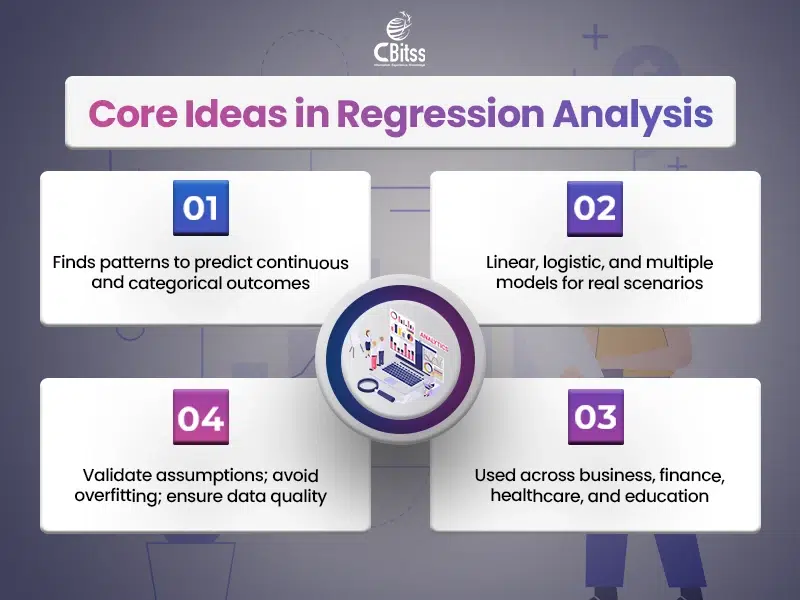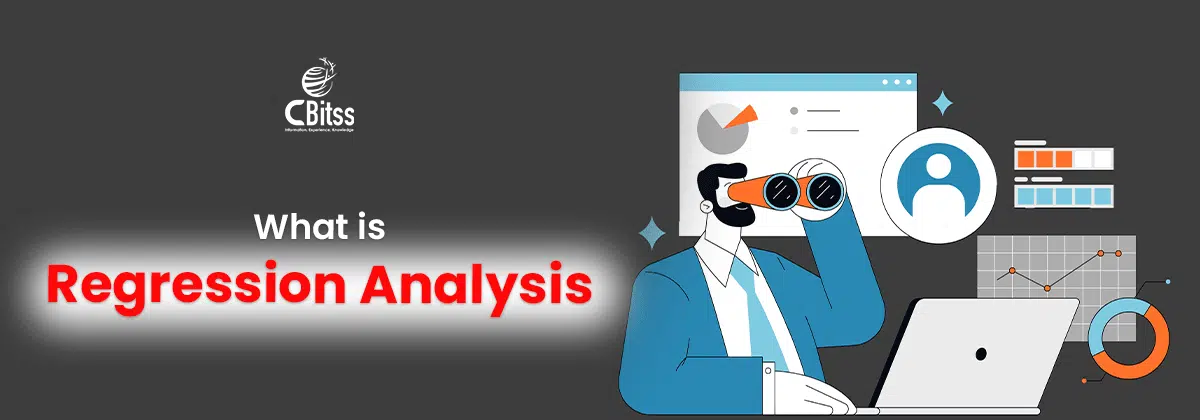Table of Contents
ToggleIntroduction
All business, science, or everyday life decisions rely on the ability to predict. What is Regression Analysis? It is a mere statistical technique that indicates the change of one factor as the other factor changes. It can be used to, say, determine the effects of advertising on sales or the effects of age on health.
This allows people to make better forecasts and smarter, fact-based decisions by looking at these patterns. That is why in 2025, the question What is egression Analysis is more significant than ever. If you’re exploring advanced skills like cloud computing course, you’ll notice that regression is often the starting point for accurate forecasting.
In this article, you will find out what the real meaning is, how it operates in simple words, and the reason why it is important in the life of professional people as well as in our day-to-day lives. At the end, you will discover how this tool can help you become a better decision maker.
Beyond Definitions: What Do We Mean by Regression?
The fundamentals are described in most of the references, but why not further? Regression is not about other things, like sketching a line on a graph. It is discovering relationships and patterns that can be revealed through numbers.
- Will an increase in price cause less demand?
- Do the study hours affect exam scores?
- Is there an effect of lifestyle on lifespan?
- Is it possible that weather conditions have an impact on crop yield?
- Are repeat sales a result of customer satisfaction?
The answer to the question, What is a regression analysis, is that it helps us to test these relationships using numbers, not guesses. It transforms questions into facts that can be
measured. It does not just indicate whether factors are related, but also the strength of the relationship between them.
In simple words, regression assists us in making assumptions about facts. It brings sanity to situations where there is confusion and assists decision-makers in operating with confidence.
If you are learning networking fundamentals or an introduction to networking, the logic of finding connections between variables will feel familiar.
Why Regression Analysis Matters in 2025
Regression Analysis is the focus of the present-day data-driven work for multiple reasons. Nowadays, we are confronting a data explosion as AI and big data generate vast volumes of information that need to be processed into insights in a short period of time.
Meanwhile, decision pressure increases; leaders and professionals can no longer afford to use simple feelings or intuition as a key point of reference. Moreover, modern tools make it simple, even for beginners, to run these analyses—just like enrolling in a PHP certification course helps anyone build coding skills without a math background.
In this case, this comes in. It has high forecasting capability as it predicts the future with numbers that you can rely on. In addition, the software today has become more accessible, whereby even a layperson can apply it with ease.
This is why knowing what is a regression analysis is no longer a nice-to-have professional skill but a required career skill in any industry.

What is Linear Regression Analysis in Practice?
People often ask about the most widespread method: what is linear regression analysis? It looks at the influence of one independent variable upon a dependent variable in a straight line relation.
For example:
- House price prediction based on size.
- Predicting advertisement spending to sales.
Equation form:
Outcome = (Constant + Slope Variable) + Error.
This provides the answer to the question: what is the linear regression analysis? This is the simplest and powerful type of regression that is applied in business and economics as well as in science. This simple yet powerful model is as essential in business forecasting as learning Android developer certification is for mobile app careers.
What is Logistic Regression Analysis and Why Use It?
- Linear regression can be used with continuous results.
- Logistic regression provides category probabilities.
- Will a customer buy (yes/no)?
- Is a patient going to recover (success/failure)?
Understanding Multiple Regression Analysis with Examples
Where life includes more than a single contributing factor, we are directed to the question What is multiple regression analysis. There are very few situations in the real world that have only a single cause.
E.g., wage may be a matter of learning, experience, and place, whereas health may be a matter of food, physical activity, and years. Multiple regression provides deeper and richer information by operating several independent variables simultaneously.
It is not over-simplistic and shows the way different factors interact to produce more effective predictions. This makes it an effective problem-solving aid to real-life issues.
This approach prevents oversimplification, similar to mastering UI UX course skills that combine design, usability, and psychology.
Learn regression analysis in easy steps designed for beginners and professionals
Comparing Different Regression Types
Now we can make a comparison between the three methods:
Type of Regression | What It Means | Extra Details |
Linear Regression | A continuous outcome of one factor | It demonstrates the effect of one variable (such as hours studied) on a numerical outcome (such as exam score). The easiest way to learn regression is linear regression, as it is the simplest. |
Logistic Regression | Categorical response, probability predictors | It does not use numbers but gives predictions in the form of categories such as yes/no or buy/don’t buy. Logistic regression is a popular tool in medicine, marketing, and risk assessment. |
Multiple Regression | A combination of several factors. | It measures the relationship between more than one variable when it comes to influencing an outcome. In this way, it is possible to prevent oversimplification and make predictions much closer to real-life situations. |
Common Mistakes in Using Regression
Even mighty weapons may not work unless they are applied properly. Adding too many variables, thereby confusing and rendering the model untrustworthy, is one of the most common mistakes. The other one is assumption ignorance, as regression only succeeds under circumstances such as linearity, independence, and normality.
A third common problem is bad data quality. When the information is incorrect, incomplete, or inconsistent, so will the projections. This is why knowing not only what linear regression analysis is but also how to make proper use of the same is what really makes the difference between an expert and an amateur.
Building a strong foundation, like understanding what is PHP, ensures you avoid these pitfalls.
Practical Applications Across Industries
Regression is not a theory, but it is a real-world application. The following are practical implementations:
1. Business– Making predictions about sales increases through marketing campaigns.
2. Finance- It involves making predictions of stock returns based on interest rates.
3. Healthcare – The analysis of the effects of the treatment plans.
4. Education- Learning the impact of teaching approach on test scores.
This demonstrates the importance of understanding logistic regression, or what is multiple regression analysis in the current day. These examples prove that mastering regression is as practical as comparing Android vs iOS development before starting a mobile career.
The Role of Regression in AI and Machine Learning
- Linear regression is applied in supervised learning.
- Logistic regression: It helps in a classification task.
- Predictive analytics is based on multiple regression.
Improve your profile with regression analysis training from trusted industry experts
Future of Regression Analysis in a Data-Driven World
So, what is Regression Analysis in the future? It is an instrument that will continue to change with technology. Even people who lack advanced statistical training will find it easy to use automated regression tools. The patterns that will be identified by AI are too complicated to be seen by humans, leading to the discovery of new information.
Improved visualization methods will also transform complex models into simple and clear images that are easy to interpret and communicate. In the future, regression will not only aid in decision-making but will be an integral component in all routine problem-solving. Just as continuous upskilling—like pursuing an Android vs iOS career path—keeps professionals relevant, learning regression will future-proof your decision-making.
Whether it’s what is linear regression analysis, logistic regression analysis or what is multiple regression analysis, the role of regression will only become increasingly significant. It will underpin the way we learn, plan, and innovate in the years ahead, whether it is business forecasting, healthcare predictions, education, or technology.

Conclusion
In summary, what is a regression analysis? It is the study of establishing the relationship between variables to predict and explain outcomes.
We examined linear regression, what logistic regression is, and what multiple regression is, and illustrated how each of the three solves various problems.
The workers who learn to use regression have the upper hand in 2025, because, at that time, their decision-making process will not be based on assumptions but on evidence.
Do you want to know regression in a step-by-step, practical way?
Enroll in our data analysis program today.
Discover not just what is Regression Analysis, but also learn to use it in business, research, and AI. Learn how to master regression to be a data boss tomorrow.

J. Julia Kamei is a professional content writer with 4+ years’ experience creating impactful content for clients in the USA, India, Canada, the UK, and Europe. An M.A. History graduate, she specializes in immigration, business, IT, digital marketing, AI, and Data Science. She also mentors students for international education and research.







